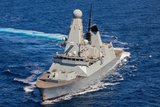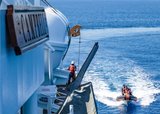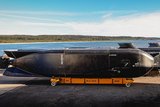Exail selected to enhance navigation capabilities of the French Navy’s OPV
The French Navy’s current fleet of OPVs have been based in the ports of Brest and Toulon. (Image: Naval Group)
Naval Group has chosen naval navigation solution provider Exail to enhance the French Navy’s Ocean Patrol Vessels (OPVs) navigation capabilities.
The deal, which forms part of the French Directorate General of Armament (DGA) Ocean Patrol Vessel programme to renew the vessels, will see Exail supply a suite of navigation hardware including the Phins Inertial Navigation Systems (INS) and Netans Data Distribution Units (DDUs).
Phins INS will be utilised on the OPVs’ operational capabilities to improve navigational accuracy and situational awareness, while Phins – a fibre optic gyroscope (FOG) technology – will aid in enhancing durability and minimising maintenance needs for coastal surveillance missions.
Manwhile, the Netans system will act to enable the OPVs to receive consistent and reliable navigation data while addressing potential cybersecurity risks, as well as adhering to safety and security standards.
Pierre-Louis Roudaut, regional sales manager at Exail, said: “Through this collaboration, we are fulfilling our commitment to simplify the lives of sailors by offering a thoughtfully designed system that precisely addresses their needs for reliability and performance.”
The French Navy’s OPVs are currently based in Brest and Toulon, while its public service patrol vessels are based in Cherbourg.
According to Shephard Defence Insight, a French procurement project known as the Patrouilleurs Hauturiers programme was launched in 2020 with the intention of replacing the Navy’s D'Estienne d'Orves-class and the Flamant-class vessels.
The DGA awarded CMN, Piriou and Socarenam a US$1 billion contract for the construction of seven new OPVs in 2023 with deliveries planned to start in 2026.
Related Programmes in Defence Insight
Patrouilleurs Hauturiers OPVS (former Patrouilleurs Océanique) [France]
More from Naval Warfare
-
![How the use of artificial intelligence will affect the US Coast Guard’s acquisitions]()
How the use of artificial intelligence will affect the US Coast Guard’s acquisitions
The USCG is pursuing AI tools to improve the way the service conducts its procurement and fielding processes.
-
![Canadian Coast Guard’s OOSV delivery is “major milestone” in fleet modernisation]()
Canadian Coast Guard’s OOSV delivery is “major milestone” in fleet modernisation
The Polar Class 6 platform is the largest CCG science-dedicated vessel and will operate on the country’s east coast.
-
![How the Anduril-HHI autonomous ship plan fits in with the US Navy’s MASC programme]()
How the Anduril-HHI autonomous ship plan fits in with the US Navy’s MASC programme
The new modular vessel is expected to be developed for both commercial and defence use, with a heavy focus on production speed and mission flexibility.





















